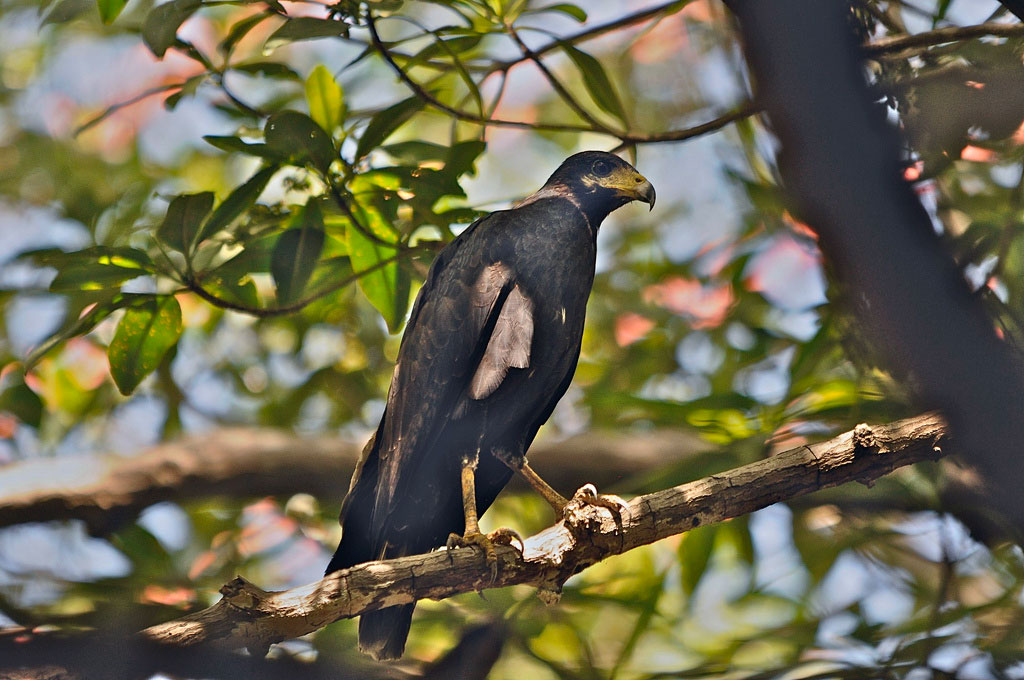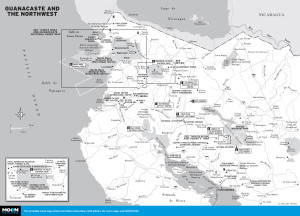
A Mangrove Black Hawk photographed on the banks of the Río Tempisque. Photo © Brian Ralphs licensed, Creative Commons Attribution.

Guanacaste and the Northwest
Parque Nacional Palo Verde ($10), 28 kilometers (17 miles) south of Bagaces, protects 13,058 hectares (32,267 acres) of floodplain, marshes, and seasonal pools in the heart of the driest region of Costa Rica—the Tempisque basin, at the mouth of the Río Tempisque in the Golfo de Nicoya. The park derives its name from the palo verde (green stick) shrub that retains its bright green coloration year-round.For half the year, from November to March, no rain relieves the heat of the Tempisque basin, leaving plants and trees parched and withered. Rolling, rocky terrain spared what is now the Lomas Barbudal reserve, in particular, from the changes wrought on the rest of Guanacaste Province by plows and cows. Here, the dry forest that once extended along the entire Pacific coast of Mesoamerica remains largely intact, and several endangered tree species thrive, such as Panamá redwood, rosewood, sandbox, and the cannonball tree (balas de cañón). A relative of the Brazil nut tree, the cannonball tree produces a pungent, nonedible fruit that grows to the size of a bowling ball and dangles from a long stem. Several evergreen tree species also line the banks of the waterways, creating riparian corridors inhabited by species not usually found in dry forests.
In all, there are 15 different habitats and a corresponding diversity of fauna. Plump crocodiles wallow on the muddy riverbanks, salivating, no doubt, at the sight of coatis, white-tailed deer, and other mammals that come down to the water to drink.
Isla de Pájaros, in the middle of the Río Tempisque, is replete with white ibis, roseate spoonbills, anhingas, wood storks, jabiru storks, and the nation’s largest colony of black-crowned night herons.Parque Nacional Palo Verde is best known as a bird-watchers’ paradise. More than 300 bird species have been recorded, not least great curassows and the only permanent colony of scarlet macaws in the dry tropics. At least 250,000 wading birds and waterfowl flock here in fall and winter, when much of the arid alluvial plain swells into a lake. Isla de Pájaros, in the middle of the Río Tempisque, is replete with white ibis, roseate spoonbills, anhingas, wood storks, jabiru storks, and the nation’s largest colony of black-crowned night herons.Three well-maintained trails lead to lookout points over the lagoons; to limestone caves; and to water holes such as Laguna Bocana, gathering places for a diversity of birds and animals. Limestone cliffs rise behind the old Hacienda Palo Verde, now the park headquarters (tel./fax 506/2200-0125), eight kilometers (5 miles) south of the park entrance.
Dry season (Nov.-Apr.) is by far the best time to visit, although the Tempisque basin can get dizzyingly hot. Access is easier at this time of year, and deciduous trees lose their leaves, making bird-watching easier. Wildlife gathers by the water holes, and there are far fewer mosquitoes and other bugs. When the rains come, mosquitoes burst into action.
The park is contiguous to the north with the remote 7,354-hectare (18,172-acre) Refugio de Fauna Silvestre Rafael Lucas Rodríguez Caballero, a wildlife refuge, and beyond that, the 2,279-hectare (5,632-acre) Reserva Biológica Lomas Barbudal (Lomas Barbudal Biological Reserve, no tel., donation). The three have a similar variety of habitats. The Lomas Barbudal park office (Casa de Patrimonio) is on the banks of the Río Cabuyo. Trails span the park from here. It’s open on a 10-days-on, 4-days-off schedule.
To the south, Parque Nacional Palo Verde is contiguous with Refugio de Vida Silvestre Cipancí (tel. 506/2651-8115), a national wildlife refuge that protects mangroves along 3,500 square kilometers (1,350 square miles) of riverside bordering the Ríos Tempisque and Bebedero. The banks of the Tempisque, which is tidal, are lined with archaeological sites.
The Organization of Tropical Studies (OTS, tel. 506/2661-4717) offers natural-history visits by advance reservation; guided walks cost $32-65, depending on the number of people. It also has mountain bikes. The park rangers will take you out on their boat, or you can hire boats in Bebedero, or Puerto Humo on the Nicoya Peninsula.
The Parque Nacional Palo Verde administration building has a run-down campsite ($2) beside the old Hacienda Palo Verde. Water, showers, and barbecue pits are available. There is also a campsite seven kilometers (4.5 miles) east near Laguna Coralillo (no facilities). It is periodically closed, so call ahead to check. You may be able to stay with rangers in basic accommodations ($12) with advance notice; for information call the Área de Conservación Tempisque office (tel. 506/2695-5908, 8am-4pm daily) in Tilarán. Spanish-speakers might try the ranger station radio phone (tel. 506/2233-4160).
Visitors can also stay in a dormitory at the Organization of Tropical Studies’ Palo Verde Biological Research Station (tel. 506/2661-4717, reservations tel. 506/2524-0607, [email protected], $98 s, $184 d, children $38, including meals and a guided walk) on a space-available basis. Eight rooms have shared baths; five rooms have private baths.
The Lomas Barbudal reserve has basic accommodations ($6 pp) and meals at the ranger station.
The main entrance to Parque Nacional Palo Verde is 28 kilometers (17 miles) south of Bagaces, along a dirt road that begins opposite the gas station and Área de Conservación Tempisque office on Highway 1. The route is signed; a 4WD vehicle is required, and high ground clearance is essential in wet season. No buses travel this route. A Jeep taxi from Bagaces costs about $30 one-way.
Coming from the Nicoya Peninsula, a bus operates from the town of Nicoya to Puerto Humo, where you can hire a boat to take you three kilometers (2 miles) upriver to the Chamorro dock, the trailhead to park headquarters; it’s a two-kilometer (1.2-mile) walk, and it’s muddy and swampy in wet season. Alternatively, you can drive from Filadelfia or Santa Cruz (on the Nicoya Peninsula) to Hacienda El Viejo; the park is four kilometers (2.5 miles) east from El Viejo, and the Río Tempisque two kilometers (1.2 miles) farther. A local boat operator will ferry you downriver to the Chamorro dock.
The unpaved access road for Reserva Biológica Lomas Barbudal is off Highway 1, at the Kilometer 221 marker near Pijijes, about 10 kilometers (6 miles) north of Bagaces. A dirt road—4WD recommended—leads six kilometers (4 miles) to a lookout point and then descends steeply from here to the park entrance. If conditions are particularly muddy, you can park at the lookout point and hike to the ranger station rather than face not being able to return via the dauntingly steep ascent from the ranger station in your vehicle. A Jeep taxi from Bagaces will cost about $50 round-trip. Palo Verde and Lomas Barbudal are also linked by a rough dirt road that is tough going in wet season.
Tour companies in San José and throughout Guanacaste offer river tours in Palo Verde, as does Palo Verde Boat Tours (tel. 506/2651-8001), departing Filadelfia, on the Nicoya Peninsula. Aventuras Arenal (tel. 506/2479-9133) offers boat trips from Bebedero. You can also explore Palo Verde from the Nicoya side of the Río Tempisque. Hacienda El Viejo (tel. 506/2665-7759), 17 kilometers (11 miles) southeast of Filadelfia, offers tours.
Excerpted from the Ninth Edition of Moon Costa Rica.